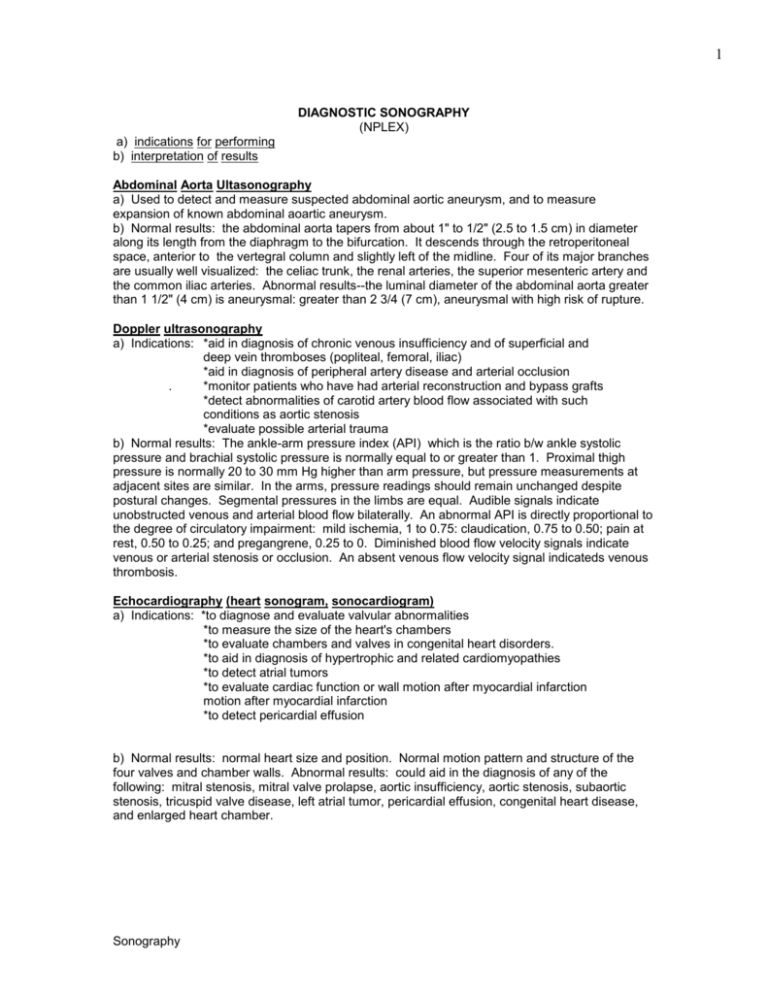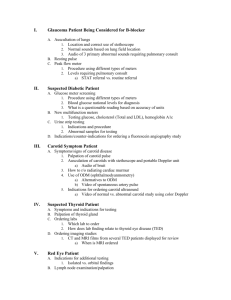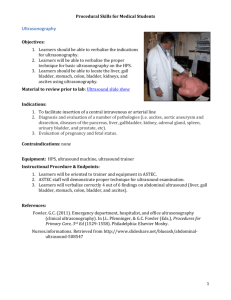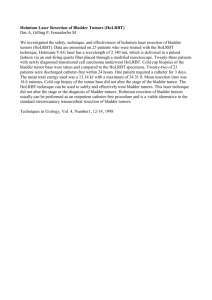Sono Graph - aaronsworld.com
advertisement

1 DIAGNOSTIC SONOGRAPHY (NPLEX) a) indications for performing b) interpretation of results Abdominal Aorta Ultasonography a) Used to detect and measure suspected abdominal aortic aneurysm, and to measure expansion of known abdominal aoartic aneurysm. b) Normal results: the abdominal aorta tapers from about 1" to 1/2" (2.5 to 1.5 cm) in diameter along its length from the diaphragm to the bifurcation. It descends through the retroperitoneal space, anterior to the vertegral column and slightly left of the midline. Four of its major branches are usually well visualized: the celiac trunk, the renal arteries, the superior mesenteric artery and the common iliac arteries. Abnormal results--the luminal diameter of the abdominal aorta greater than 1 1/2" (4 cm) is aneurysmal: greater than 2 3/4 (7 cm), aneurysmal with high risk of rupture. Doppler ultrasonography a) Indications: *aid in diagnosis of chronic venous insufficiency and of superficial and deep vein thromboses (popliteal, femoral, iliac) *aid in diagnosis of peripheral artery disease and arterial occlusion . *monitor patients who have had arterial reconstruction and bypass grafts *detect abnormalities of carotid artery blood flow associated with such conditions as aortic stenosis *evaluate possible arterial trauma b) Normal results: The ankle-arm pressure index (API) which is the ratio b/w ankle systolic pressure and brachial systolic pressure is normally equal to or greater than 1. Proximal thigh pressure is normally 20 to 30 mm Hg higher than arm pressure, but pressure measurements at adjacent sites are similar. In the arms, pressure readings should remain unchanged despite postural changes. Segmental pressures in the limbs are equal. Audible signals indicate unobstructed venous and arterial blood flow bilaterally. An abnormal API is directly proportional to the degree of circulatory impairment: mild ischemia, 1 to 0.75: claudication, 0.75 to 0.50; pain at rest, 0.50 to 0.25; and pregangrene, 0.25 to 0. Diminished blood flow velocity signals indicate venous or arterial stenosis or occlusion. An absent venous flow velocity signal indicateds venous thrombosis. Echocardiography (heart sonogram, sonocardiogram) a) Indications: *to diagnose and evaluate valvular abnormalities *to measure the size of the heart's chambers *to evaluate chambers and valves in congenital heart disorders. *to aid in diagnosis of hypertrophic and related cardiomyopathies *to detect atrial tumors *to evaluate cardiac function or wall motion after myocardial infarction motion after myocardial infarction *to detect pericardial effusion b) Normal results: normal heart size and position. Normal motion pattern and structure of the four valves and chamber walls. Abnormal results: could aid in the diagnosis of any of the following: mitral stenosis, mitral valve prolapse, aortic insufficiency, aortic stenosis, subaortic stenosis, tricuspid valve disease, left atrial tumor, pericardial effusion, congenital heart disease, and enlarged heart chamber. Sonography 2 Echoencephalography (brain sonogram) a) Indications: to determine the position and size of midline cerebral structures. b) Normal results: in a healthy person, the third ventricle is centered in the skull, no more than 2 to 3 mm from the midline. Other midline structures, such as the right and the left lateral ventricles, also appear in their normal anatomic positions. Abnormal results would show a shift in midline structures of more than 3 mm. If the third ventricle is enlarged by 10 mm or more (7 mm or more in children), further investigation for a possible space-occupying lesion is necessary. Abnormal results such as structural shifts may be caused by cerebral edema or by subdural and extradural hemorrhage. Gallbladder and biliary system ultrasonography a) Indications: to confirm diagnosis of cholelithiasis, to diagnose acute cholecystitis, and to distinguish b/w obstructive and noobstructive jaundice. b) Normal results show normal size, contour, and position of the gallbladder, cystic duct and common bile duct. Abnormal results may reveal cholelithiasis, cholecystitis, polyps within the gallbladder, and carcinoma of the gallbladder. Liver Ultrasonography a) Indications: *distinguish b/w obstructive and nonobstructive jaundice *screen for hepatocellular disease *detect hepatic metastases and hematoma *define cold spots as tumors, abscesses, or cysts b) Normal results would show normal size, shape, and position of the liver. Abnormal results may reveal biliary duct obstruction, metastasis to liver, primary hepatic tumors, intrahepatic abscesses, cysts, or hematomas. Ocular Ultrasonography (eye and orbit sonogram) a) Indications: *aid in evaluating the fundus in an eye with an opaque medium, such as a cataract *aid in diagnosis of vitreous disorders and retinal detachment *diagnose and differentiate b/w intraocular and orbital lesions, and to follow their progression through serial examinations *help locate intraocular foreign bodies b) Normal results: the optic nerve and posterior lens capsule produce echoes that take on characteristic forms on A- and B-scan images. The posterior wall of the eye appears as a smooth, concave curve: retrobulbar fat can also be identified. The lens and vitreous, which do not produce echoes, can also be identified. Pancreas Ultrasonography a) Indications: to aid in diagnosis of pancreatitis, pseudocysts, and pancreatic carcinoma. b) Normal results would show normal size and position of the pancreas. Abnormal results may reveal pancreatitis, pancreatic carcinoma or pseudocyst. Sonography 3 Pelvic Ultrasonography (a full bladder is desirable) a) Indications: *detect foreign bodies, such as intrauterine devices *distinguish b/w cystic and solid masses (tumors) in uterus and ovaries *measure organ size *evaluate fetal viability, position, gestational age, and growth rate *detect multiple pregnancy *confirm fetal abnormalities (molar pregnancy, abnormalies of arms, legs, spine, heart, head, kidneys, and abdomen) and maternal abnormalities such as (posterior placenta and placenta previa) *guide amniocentesis by determining placental location and fetal position b) Normal results: The uterus is normal in size and shape. The ovaries are normal in size, shape and sonographic density. No other masses are visible. If the patient is pregnant, the gestational sac and fetus are of normal size for dates. Multiple pregnancy can be revealed after 13 to 14 weeks' gestation. Abnormal results may reveal: cystic mass, solid mass, foreign body, placenta previa, abruptio placenta, fetal abnormalities, fetal malpresentation, cephalopelvic disproportion, inapproproate fetal size for date, and death of fetus. Renal Ultrasonography a) Indications: *determine the size, shape and position of the kidneys, their internal structures, and perirenal tissues *evaluate and localize urinary obstruction and abnormal accumulation of fluid *assess and diagnose complications fossowing kidney transplantation b) Normal results reveal normal size, shape and position of kidneys. Abnormal results may reveal: cysts, tumors, or abscesses involving the kidneys, cysts or tumors involving the adrenal glands, advanced pyelonephritis or glomerulonephritis, hydornephrosis, obstruction of ureters, congenital abnormalies, renal hypertrophy and rejection of renal transplants. Spleen Ultrasonography a) Indications: *demonstrate splenomegaly *monitor progression of primary and secondary splenic disease and to evaluate the effectiveness of therapy *evaluate the spleen after abdominal trauma *help detect splenic cysts and subphrenic abscesses b) Normal results reveal normal size, shape and position of the spleen. Abnormal results may reveal splenomegaly, rupture, hematoma, abscess, cysts, and tumors. Thyroid Ultrasonography a) Indications: *evaluate thyroid structure *differentiate b/w a cyst and a tumor *determine the depth and dimension of thyroid nodules *monitor the size of the thyroid gland during suppressive therapy b) Normal results reveal normal size and shape of the thyroid gland. Abnormal results may reveal cysts, tumors or thyroid nodules. Urinary Bladder Ultrasonography a) Indications: *determine the presence of residual urine *detect bladder tumors or cystitis *detect an overdistended bladder *determine the extent of a known bladder tumor b) Normal results show bladder is normal in contour and volume. There is no significant residual urine. No masses are identified within the bladder or external to it. Abnormal results may reveal an abnormally distended bladder, residual urine, bladder tumors, masses or collections external to bladder, extent of malignant tumors of bladder, bladder calculi, cystitis, bladder diverticula, and ureteroceles. Sonography 4 Sonography









